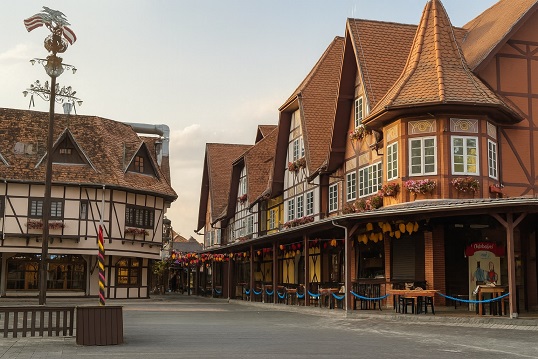
When most people imagine Brazil, they picture samba, soccer, and sun-drenched beaches. But deep in the lush Atlantic Forest of southern Brazil lies a town that feels strikingly different. Welcome to Blumenau – a city where half-timbered houses line the streets, bratwurst is a staple dish, and German is still heard alongside Portuguese.
Blumenau is not just another city in the state of Santa Catarina. It’s a living remnant of a unique chapter in Brazilian and German history – a cultural outpost shaped by the dreams and resilience of 19th-century German immigrants. Today, it stands as the most iconic German-influenced city in South America and a testament to how cultural identity can be preserved across oceans and generations.
In this guide, we explore the origins, culture, architecture, food, and festivals that make Blumenau an extraordinary blend of Brazil and Bavaria.
➡️ Related: The Founding of Blumenau: German Pioneers in Brazil
A German Seed in Brazilian Soil: How Blumenau Was Born
Blumenau was founded in 1850 by Dr. Hermann Bruno Otto Blumenau, a German pharmacist and visionary who believed German settlers could build a new life in Brazil’s fertile but undeveloped interior. With 17 settlers from Germany, he established a colony along the banks of the Itajaí-Açu River.
Over the next decades, thousands of immigrants from Germany (especially from Pomerania, Hesse, Baden, and Bavaria) followed, driven by economic hardship, political upheaval, and the promise of land and opportunity. Unlike in many immigrant cities, these German settlers preserved their customs, language, and institutions, often in relative isolation from Portuguese-speaking Brazilians.
The result? A town that grew with Fachwerk architecture, Lutheran churches, German-language schools, and sausage-making traditions that still flourish today.
Cultural Identity That Endures
Blumenau’s identity is not a museum piece – it’s alive in daily life. Locals still wear Dirndls and Lederhosen during festivals, businesses proudly display German names, and traditions like coffee and cake at 4 p.m. (Kaffeezeit) remain part of the rhythm of life.
Here’s how German culture appears in everyday Blumenau:
- Street signs and shop names in German
- Lutheranism as a dominant faith
- German language media and schools
- Culinary staples like Kassler, Eisbein, and Sauerkraut
- Strict recycling and cleanliness norms, reflecting Ordnungsliebe (love of order)
Architecture: Fachwerk in the Tropics
One of Blumenau’s most visually striking features is its architecture. The city center, especially around Rua XV de Novembro, showcases classic German half-timbered buildings (Fachwerkhäuser), steeply pitched roofs, flower boxes, and red tiles.
Key landmarks include:
- Castelinho da Havan: A replica of a 16th-century building from Michelstadt, Germany
- City Hall (Prefeitura de Blumenau): With exposed timber framing and Bavarian design
- Vila Germânica Park: Designed in alpine style, it hosts the Oktoberfest and serves as a cultural center year-round
These buildings are not just nostalgic ornaments – they anchor the community’s sense of place and pride.
➡️ Read more: German Architecture in Blumenau: Fachwerk Houses in the Tropics
The World’s Second-Largest Oktoberfest
Blumenau may be in Brazil, but every October, it becomes a global stage for German festivity. The city hosts the second-largest Oktoberfest in the world, after Munich. Since its founding in 1984 (following a devastating flood), the festival has grown into a mega-event that attracts more than 700,000 people annually.
The festival features:
- Traditional beer halls with local and imported brews
- Bavarian music, oompah bands, and folk dances
- Costume parades and shooting clubs
- Authentic German food
- Contests like the Chopp em Metro (beer-drinking contest by the meter)
Oktoberfest in Blumenau is more than a party. It’s a cultural affirmation and economic lifeline, generating jobs, tourism, and global visibility.
➡️ Dive deeper: Blumenau’s Oktoberfest: How Brazil Celebrates Bavaria
Language and Customs: Plattdeutsch and Torte in the Rainforest
While fewer people now speak German fluently in Blumenau, many older residents and cultural groups maintain regional dialects like Plattdeutsch or Hunsrückisch. Efforts to preserve the language include:
- Cultural associations offering German classes
- Bilingual signage and historical documents
- Local media programs in German
German customs are also visible in:
- Festivals beyond Oktoberfest, such as Sommerfest and Weihnachtsmarkt
- The tradition of cleaning sidewalks and orderly public behavior
- Lutheran church services and choir concerts
- Culinary rituals – from hearty breakfasts to afternoon coffee and cake
➡️ Related article: Food, Language, and Customs: Everyday German Life in Blumenau
Modern Challenges and Multicultural Harmony
Blumenau today is a modern Brazilian city with over 350,000 residents, a strong economy, and a thriving textile industry. While it celebrates its German heritage, it also reflects Brazil’s multiculturalism. Portuguese is the dominant language, and other European, African, and Indigenous influences are part of the region’s tapestry.
Challenges include:
- Balancing tourism with cultural authenticity
- Revitalizing the German language among younger generations
- Managing urban growth while preserving architectural heritage
Still, Blumenau’s commitment to cultural continuity is rare and remarkable in the globalized age.
Blumenau’s German Identity: A Legacy Worth Preserving
What makes Blumenau’s story so fascinating is not just that German immigrants built a successful colony – but that their traditions endured, evolved, and became integral to Brazilian identity. The city is a vibrant example of cultural coexistence – where being proudly German doesn’t mean being any less Brazilian.
From the bratwurst stands to the brass bands, from Fachwerk facades to bilingual school signs, Blumenau offers a living lesson in heritage, resilience, and joyful identity.
A Corner of Bavaria in Brazil’s Rainforest
Blumenau is not a theme park or a historical simulation. It is a real city where tradition and progress go hand in hand. Whether you visit for Oktoberfest or to stroll its storybook streets, you’ll find more than good beer and pretty houses – you’ll find a community where culture is cherished and shared.
So next time you think of Brazil, remember that samba has a sibling: the polka. And its heart beats strong in Blumenau.
➡️ Continue the series:
